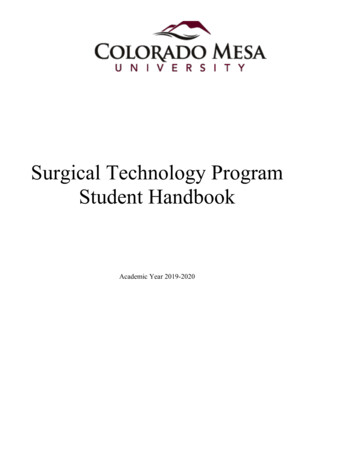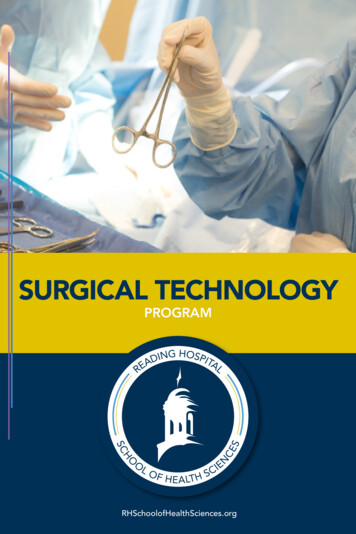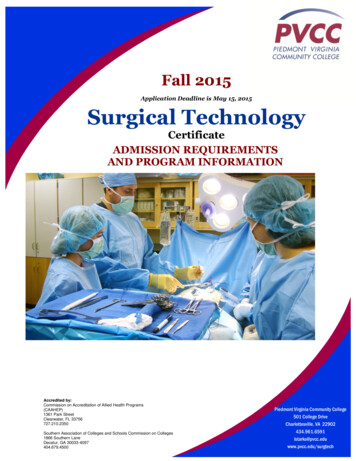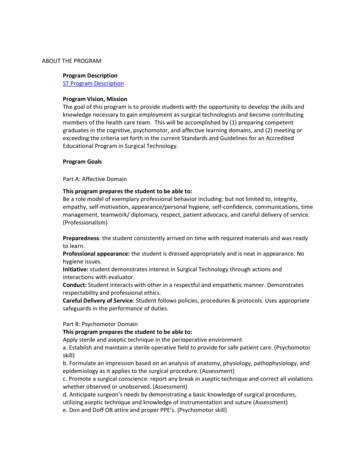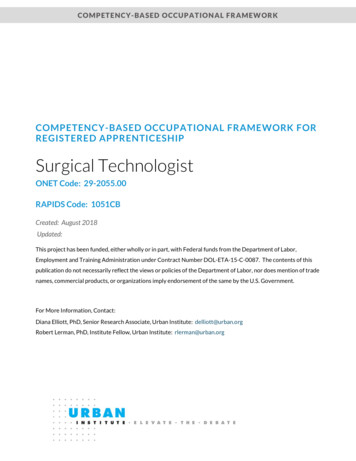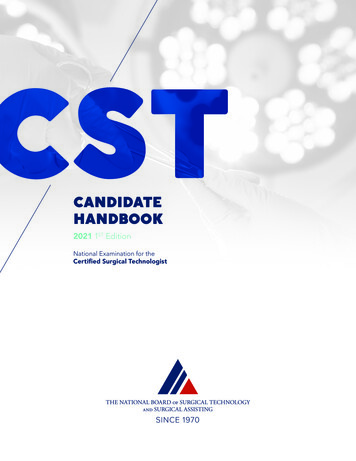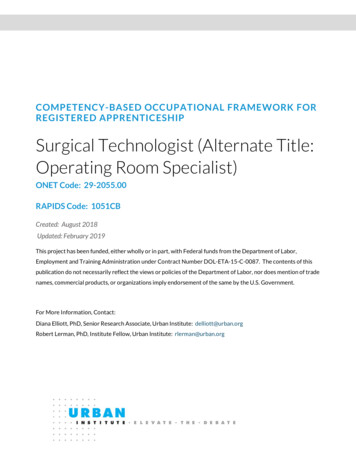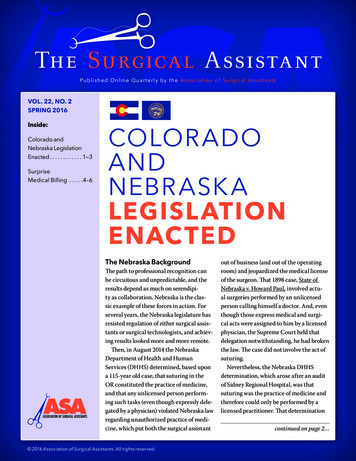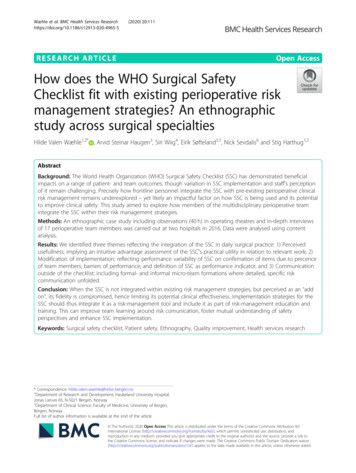
Transcription
Wæhle et al. BMC Health Services 2020) 20:111RESEARCH ARTICLEOpen AccessHow does the WHO Surgical SafetyChecklist fit with existing perioperative riskmanagement strategies? An ethnographicstudy across surgical specialtiesHilde Valen Wæhle1,2* , Arvid Steinar Haugen3, Siri Wiig4, Eirik Søfteland3,5, Nick Sevdalis6 and Stig Harthug1,2AbstractBackground: The World Health Organization (WHO) Surgical Safety Checklist (SSC) has demonstrated beneficialimpacts on a range of patient- and team outcomes, though variation in SSC implementation and staffʼs perceptionof it remain challenging. Precisely how frontline personnel integrate the SSC with pre-existing perioperative clinicalrisk management remains underexplored – yet likely an impactful factor on how SSC is being used and its potentialto improve clinical safety. This study aimed to explore how members of the multidisciplinary perioperative teamintegrate the SSC within their risk management strategies.Methods: An ethnographic case study including observations (40 h) in operating theatres and in-depth interviewsof 17 perioperative team members was carried out at two hospitals in 2016. Data were analysed using contentanalysis.Results: We identified three themes reflecting the integration of the SSC in daily surgical practice: 1) Perceivedusefullness; implying an intuitive advantage assessment of the SSCʼs practical utility in relation to relevant work; 2)Modification of implementation; reflecting performance variability of SSC on confirmation of items due to precenceof team members; barriers of performance; and definition of SSC as performance indicator, and 3) Communicationoutside of the checklist; including formal- and informal micro-team formations where detailed, specific riskcommunication unfolded.Conclusion: When the SSC is not integrated within existing risk management strategies, but perceived as an “addon”, its fidelity is compromised, hence limiting its potential clinical effectiveness. Implementation strategies for theSSC should thus integrate it as a risk-management tool and include it as part of risk-management education andtraining. This can improve team learning around risk comunication, foster mutual understanding of safetyperspectives and enhance SSC implementation.Keywords: Surgical safety checklist, Patient safety, Ethnography, Quality improvement, Health services research* Correspondence: hilde.valen.waehle@helse-bergen.no1Department of Research and Development, Haukeland University Hospital,Jonas Liesvei 65, N-5021 Bergen, Norway2Department of Clinical Science, Faculty of Medicine, University of Bergen,Bergen, NorwayFull list of author information is available at the end of the article The Author(s). 2020 Open Access This article is distributed under the terms of the Creative Commons Attribution 4.0International License (http://creativecommons.org/licenses/by/4.0/), which permits unrestricted use, distribution, andreproduction in any medium, provided you give appropriate credit to the original author(s) and the source, provide a link tothe Creative Commons license, and indicate if changes were made. The Creative Commons Public Domain Dedication o/1.0/) applies to the data made available in this article, unless otherwise stated.
Wæhle et al. BMC Health Services Research(2020) 20:111BackgroundThe World Health Organizationʼs (WHO) Safe SurgicalChecklist (SSC) [1] has been advocated globally, and insome cases mandated as a surgical safety intervention,aiming to improve information exchange within theperioperative team, and to critically review specific safetyitems [2]. Clinical effectiveness studies have demonstrated beneficial impact of the SSC implementation ona range of patient- and team outcomes, including mortality rates, complication rates, length of in-hospital stay,teamwork, and adherence to safety processes [3–10].Also, high-fidelity use of the SSC, i.e. suitable use of allthree parts of it, has been shown of crucial importancein order to achieve improved outcomes [11]. The evidence thus supports that high quality implementation ofSSC is required for positive effects to be attained [12].Studies on the implementation of the SSC, however, havehad mixed results [13, 14]. Further, research shows that theSSC is sometimes used patchily, and that SSC implementation quality differs among hospitals, surgical specialties, surgical staff members, and among specific items and parts ofthe checklists [15–18]. In addition, longitudinal implementation studies of the SSC have offered only modest, sustained impacts on staff attitude- and satisfaction, andsurgical team perspectives [19–22]. Instead, conflictingfindings and failings to link the SSC to improved outcomesare causing some at least scepticism around its true potential as a patient safety intervention [15]. Questions on howlack of SSC compliance might actually introduce new risksnot present before have also been raised [23], promptingcalls for the reconsideration of policies mandating the SSCas an organisational safety practice [24].Although variations in SSC fidelity of use have beendocumented, there is limited understanding of why suchvariations occur [25–28]. Safety interventions, their implementation and the clinical and organisational contextwithin which they are applied are intertwined and mutually interacting, thus influencing how such interventionsactually work in practice (or not) [29]. Structuralchanges in operating staff workflow and their perceptions of the SSC and patient safety are reccomended toimprove SSC implementation [25].Ultimately, the reduction of risk SSC aims to achieveis not achieved by ‘ticking off’ checklist items, but by theactions and behaviours of the perioperative team theSSC calls for. [27] A knowledge gap still remains of howperioperative staff integrate (or not) the SSC into theirpre-existing risk management strategies and tools; andhow their risk perceptions are impacted by the use ofthe SSC. Studies that seek to understand the role ofadaptive, human and social practices in safety effortssuch as the SSC are therefore called for [30–32].Reflecting on the purpose of the SSC, we propose thatfor a safety intervention aiming at human behaviour, it isPage 2 of 11essential that all team members share an understanding ofclinical risk and risk management strategies; and that theintervention is actually embedded effectively and efficiently into existing safety practices. Thus, the aim of thisstudy was to explore how the multidisciplinary perioperative team members integrate the SSC as part of their riskmanagement strategies in perioperative care.MethodsDesignThis is a prospective ethnographic study. Multidisciplinaryperioperative teams were observed during performance ofthe SSC in operating theatres (OTs), followed by face-to-faceinterviews of key informants. While focusing on descriptionand analysis of “everyday” routine practice in their naturalsettings, this design is well suited to capture both participants’ use of SSC and risk communication patterns, as wellas their perceptions of patient safety challenges [32, 33].Study settingThe study was conducted in two hospitals, a tertiaryteaching hospital and a central community hospital,within one of the four Regional Health Authorities in thecountry. Hospital characteristics are described in Table 1.The hospitals operate within separate organisational structures, and perioperative routines vary accordingly. Onesurgical unit at each hospital was included in the study.These hospital units served as surgical study-clusters in alarge stepped wedge, cluster randomised control trial ofthe WHO SSC’s impact on patient outcome in 2009–2010, and were therefore recruited [8]. The adapted national version of the WHO SSC had been implemented atboth the surgical units, following an educational programwith standardised lectures and dissemination events [22].Generally there were customisations of the SCC as recommended by the WHO at the two hospitals, with additionaldepartment level customisations in the tertiary teachinghospital. These customisations were individual and notcoordinated or consistent, but according to local routinesand practice. Following initial introduction, SSC utilisationwas monitored by both the local hospitals and the Regional Health Authority, as part of the national PatientSafety Programme: In Safe Hands, commissioned by theMinistry of Health and Care Services [34]. The observedSSC utilisation indicator was defined as: number of surgeries where the SSC was used over total number of performed surgeries [34]. Longitudinal monitoring of SSCcompliance data from 2014 to 2016, showed differencesbetween the two hospitals (Fig. 1), such that compliancewas lower for hospital 1 compared to hospital 2.Data collectionData collection involved non-participant observations andinterviews together with longitudinal SSC compliance rate
Wæhle et al. BMC Health Services Research(2020) 20:111Page 3 of 11Table 1 Hospital and interviewee characteristicsHOSPITAL CHARACTERISTICSINTERVIEWEES CHARACTERISTICSSizea Number NursescN 17 eonCardiovascularperfusionisteSexfemale/maleWork – experienceyears qualified inprofession - rangeHospital1:1066 33,584Tertiaryreferralhospital22 yreferralhospital2 specialisedunits84403/53–30Total1310 41,471––178727/103–327887abSize: 2016 Occupancy rate (Statistics Norway) bed-days/available bed-days. Surgical hospital stays: 2016 reported stays with one or more surgical procedure,based on the classification system of the Norwegian diagnosis related groups (N-DRG, Norwegian Patient Registry. cAuthorisation requirements in Norway: 3-yearbachelor degree in Nursing-180 ECTS§ either a 1,5-year Specialist education program-90 ETCS, or a 2-year Master’s program-120 ECTS at a College Universitydegree. dAuthorisation requirements in Norway: 6-year cand. Med degree, 360 ECTS 6,5 years of specialist training before qualification as consultant.eAuthorisation requirements in Norway: 3-year bachelor degree in Engineering or Nursing180 ECTS a 2-year Master’s program-120 ECTS at a College Universitydegree. §European Credit Transfer and Accumulation System (ECTS) creditsreports derived from administrative data systems (described in detail below). Data triangulation was usedacross time, hospital settings and professional groups, tocapture a contextualised ‘portrait’ of the SSC within thestudied settings [35, 36].Perioperative observationsWe observed 6 complete surgical cases at each of the studysites. Observations took about 1 week per site, and coveredspecialties of general- and highly specialised surgery. Theobservations (40 h) covered scheduled surgical proceduresat dates agreed upon beforehand by the service managers.All cases were elective, done under general anaesthesia during normal working hours, and covered both complex casesand day-surgeries. Cases where any staff member or thepatient withheld consent were excluded. The observationsaimed to map routine behaviours of “work as done”, ie. actual SSC team performance, which differs from the concept“work-as-imagined” (how it should have been done), as thelatter cannot capture context and nuances of clinical workor how circumstances vary [37].The checklist was initially introduced to the hospitals in arandomised controlled trial in 2009–2010, as described byHaugen et al. [8] The data for this study were collected in2016 at one hospital at a time, with team observations taking place prior to interviews, starting at the central community hospital (hospital 2 in Table 1). The data collection atthe tertiary teaching hospital was carried out a couple ofmonths later, as the process of recruiting informants tookslightly longer time. Observations of team interactions andFig. 1 Longitudinal monitoring of SSC compliance rates in surgical procedures (n total numbers of procedures/hospital/year) performedbetween 2014 and 2016 for study hospital 1. (tertiary teaching hospital) and study hospital 2. (central community hospital)
Wæhle et al. BMC Health Services Research(2020) 20:111communications were noted and reviewed by the researchteam. These field notes were used to develop the interviewtopic guide and inputs to the data analysis.InterviewsInterviews were carried out with 17 members of the perioperative teams, each typically consisting of one or twosurgeons, at least two operating theatre nurses, one anaesthesiologist, one or two nurse anaesthetists, and occaisionally one cardiovascular perfusionist. Interview topicscovered SSC use, team-work and communication patterns(interview guide in Additional file 1). All healthcarepersonnel in the perioperative team were considered keyinformants. Hence, a maximum variation purposive sampling strategy [38] was used to elicit professional perspectives on SSC utilisation in the OTs. Invitations toparticipate were initially reviewed and approved by hospitals managers at the respective study hospitals. Participants were recruited by the surgical unit managers.Professionals with variable length of perioperative workexperience were targeted for sampling; their characteristics are described in Table 1. All interviews were conducted in the OT departments, in areas free fromdistractions (e.g., meeting rooms). Each participant wasinterviewed once. The interviews lasted between 28 and47 min, with median length 36 min. The interviews wereaudiotaped, and transcribed verbatim for analysis.All observations and interviews were performed byHVW (MSc, senior nurse anaesthetist, trained in qualitative research). A second researcher, ASH (PhD, seniornurse anaesthetist, trained in qualitative research) participated in 6 h of the observations to ensure trustworthiness of the findings.AnalysisData from observations and interviews were analysedusing an inductive, content analysis approach [39]. Thefollowing steps were used: HVW, ASH, SW (seniorsafety scientist, trained in qualitative methods), and SH(quality manager and senior scientist), read the transcribed interviews forming units of analysis. HVW identified and coded transcript sections into ‘meaning units’,followed by relating categories and themes, constitutingthe manifest content [39]. Observational data were usedto support the interview data analysis and contributed tothe formation and interpretation of the latent content,and emerging themes. ASH, SW and SH reviewed thecoding and interpretations. Preliminary themes, subthemes and quotes were then discussed amongst all authors, using group consensus to strengthen coherence ofthe findings [40]. The finalised dataset is presented inemerging themes.Page 4 of 11ResultsAnalysis of observations and interviews identified threemajor themes: (1) Perceived usefullness, (2) Modificationof implementation, and (3) Communication outside ofthe checklist. In the following sections, each of thethemes are presented in detail. The identified themesand corresponding categories are presented in Table 2,with representative verbatim quotes and observationnotes (in italics) to illustrate the findings.Perceived usefullnessParticipants expressed various views related to SSC’s practical utility. The anaesthesia team (nurse anaesthetists andanaesthesiologists) perceived the SSC to lack practicalvalue, especially the “Sign-In” part, which was perceived asnot adding anything new to reduce anaesthetic risk. Theyreported that they had good control of procedures andtasks before induction of anaesthesia. Existing checkingmechanisms and protocols were considered sufficient, aspre-anaesthetic patient risk assessments; e.g. difficult airways, medications, allergies were performed in advance,and safety tests and -checks of the anaesthesia machine, equipment and -medications, were incorporated in existingroutines and reviewed prior to induction of anaesthesia.Checks performed by the anaesthesia team during the preoperative phase were aligned with their roles and responsibilities, acknowledged by both the anaesthesia team andother perioperative members. In addition, some anaesthesiologists expressed a need of retrieving surgical information regardless of the SSC, which in their opinion madereviews of SSC “Sign- In” items superfluous. Yet, someanaesthesiologists expressed a need for more time to reviewand handle high-risk patients together with the nurseanaesthetists, during a pre-anaesthesia briefing.Interestingly, however, other staff-members describedsituations where they experienced the SSC as being particularly useful i.e.; by confirmation of patient identity, asa reminder-list of important safety checks, especially forprocedures that might vary according to types of surgeries,or patient specific conditions such as administration ofsurgical antibiotic prophylaxis. OT nurses described howsurgical equipment reviews during “Time-Out” were advantageous, as well as tissue-sample labelling doublechecks at “Sign-Out”. SSC was also highly valued in orderto provide predictability in the OT, e.g., logistics in OTscheduling, timing of anaesthesia, and for preparation andreports to post-anaesthesia ward. Nurses in particular, reported an ease of workflow when everybody in the teamknew the surgical plan. In addition, the “Sign-Out” provided a sum-up of the surgery, which were reported beingof help to understand exactly what procedures that hadbeen performed. This was considered helpful in correctsurgical procedure codings. Introduction of the teammembers during SSC “Time-Out” was also described by
Wæhle et al. BMC Health Services Research(2020) 20:111Page 5 of 11Table 2 Themes and categories with illustrative participant quotes and observation notes (in italics)THEMECATEGORYPerceived usefullnessLack of practical utility Anaesthesiologist: Before I anaesthetise the patient, I know all the parameters for my patients,I check their circulation, and I know about their vascular occlusions and specific arterial stenosis,and I feel I have complete control of the patient, so . It is hard to think that the checklist willprovide extra safety for me.Anaesthesiologist: Patient safety is part of our training as anaesthesiologists from the verybeginning! Eh- check of the anaesthesia machine, instruments, the patients, and practicallychecks of everything we do! Double control of every blood products provided, medications,everything! In addition to assessing the patient in person and talking to them prior to surgery.We have always performed these items; it is part of the standardised pre-operative anaesthesiaassessment and preparations.Nurse anaesthetist: The anaesthesia machine is not due to any variation, it should be checkedprior to every anaesthesia. We do not admit patients into the OT unless the anaesthesiamachine is OK.Surgeon: Well, the SSC has a function, in a very simplistic way, but it does not have a propercontrol function, the way it is supposed to, because we have so many checks and controlmechanisms incorporated. So, I don’t think that the SSC is as important to us, as to othersurgical departments, which have other pre-operative assessment routines. We have so manypoints of assessment, where our patients are discussed and evaluated.Modification ofimplementationILLUSTRATIVE QUOTES FROM PARTICIPANTS (Observation notes in italics)Perceived benefitsOperating theatre nurse: The SSC is useful as a reminder of double checks of labelling tissuesamples, and to make sure the right surgical equipment is present. Surgical routines arecomplicated when you are a beginner Nurse anaesthetist: I value how the SSC may contribute in aligning the surgical andanaesthesia plan for the entire team.Surgeon: The team introduction is a nice way to start team working; the “Time-Out” is in a waya mental team-calibration.Review andconfirmation of itemsCardiovascular perfusionist: And occasionally, I may have to call out if there is something Ibelieve is required or something has been omitted, i.e. that the patient has low haemoglobinlevels, and I need to take action. In addition, during haemodilation, I avoid infusing too muchfluid in the machine. Then I tell the surgeon and anaesthesiologist what I intend to do, tomake them understand what I intend to do.Operating theatre nurse: Some surgeons that are more reluctant than others, they just startto mumble through the SSC as soon as they enter the OT, and then proclaim to haveperformed time-out. Then, it is required from an OT nurse to be determined and speak up, andsay, «no, this is not good enough! Everybody needs to know what you just said! » Sometimes Ihave to add: «No, this was not loud enough, you have to repeat the SSC! » However, to speakup requires some years of work experience.Operating theatre nurse: I think the SSC is a good thing, but I miss team concentrationduring its performance Things have improved, from the beginning until now, but there is stilltoo much disturbance during SSC performance. I really miss that everybody stops and paysattention. Due to the workflow in the OT, there is always someone who pursuits some kind ofwork, and does not stop. In addition, you need to pay full attention for the SSC to beadvantageous.Nurse anaesthetist: But it is obvious, the SSC performance is totally depending on thephysicians participation. As soon as they became more involved, both performance andcompliance increased.Presence of teammembersNurse anaesthetist: Personally, I prefer to perform the sign-in with the anaesthesiologist beingpresent in the OT, I think it is embarrassing to repeat the questions and items I have asked thepatient previously, upon arrival in the OT. So I have almost stopped to ask the patients abouttheir potential allergies, and so on. The anaesthetist repeats everything when they arrive in OTanyway.Observation: The team compositions varied during the different parts of the SSC performance; Thenurse anaesthetist, operating theatre nurse and anaesthesiologist were present during “Sign-In”. Thenurse anaesthetist, operating theatre nurse, surgeon(s) and anaesthesiologist (occasionally) werepresent during “Time-Out”. The nurse anaesthetist, operating theatre nurse, surgeon(s) andanaesthesiologist (occasionally) were present during “Sign-Out”.Barriers ofperformanceNurse anaesthetist: Well, you don’t want a conflict within the OT, you’re in a way a bit tired ofthat, so you try once more to perform the SSC, and if you do not receive any attention, youjust let it go and tick off the box, even though it has not been performed.Nurse anaesthetist: It is so important to keep the SSC short, because it does in a way disturbour workflow. You are about to start induction of anaesthesia, and then; «No, no, we have tostop and perform the SSC! » Our workflow is interrupted, and it is very disturbing andfrustrating.Operating theatre nurse: The anaesthesia team is responsible for the anaesthesia, medications . It is their responsibility. Questioning them about this is like questioning them whether theyhave done their job or not. .
Wæhle et al. BMC Health Services Research(2020) 20:111Page 6 of 11Table 2 Themes and categories with illustrative participant quotes and observation notes (in italics) (Continued)THEMECommunication outsideof the checklistCATEGORYILLUSTRATIVE QUOTES FROM PARTICIPANTS (Observation notes in italics)Registration practicesObservation: At the surgical units in hospital 2, SSC performance was ticked off either after “SignIn”, or the “Time-Out” part. There was only one box that needed to be ticked off electronically, inorder for the SSC to be registered as performed. At the surgical unit at hospital 1, all three parts ofthe checklist had to be ticked off as three separate boxes in order for the SSC to be registered asperformed.Patient specific riskcommunicationAnaesthesiologist: In general, we have contact with the cardiovascular perfusionist prior tosurgery, to inform them about patient specific details such as medications, because they don’tread the patient records the same way we do.Operating theatre nurse: . And if bleeding is involved, we need to notify the anaesthesiateam about the estimations of blood volume collected in the surgical suction, before otherfluids are added.Selectedcommunication ofrisksCardiovascular perfusionist: and these preparations are being discussed between thesurgeon and the cardiovascular perfusionist prior to surgery.Operating theatre nurse: In most cases, we have direct communication with theanaesthesiologist during induction of anaesthesia, and ask permission to start our preparations,such as positioning the patient, or inserting the urinary tract catheter.Anaesthesiologist: and then, the surgeons talk about the details of the surgery they haveperformed, while rushing out of the OT, right? And then you have to talk with them afterwardsanyway, due to potential considerations post-operatively, like the follow-up antibiotic prophylaxis. Then you have to initiate contact anyway, because certain things require a follow-up.some surgeons as unifying the team to structure theirfocus before incision. This was especially useful for newand/or unexperienced team-members.Modification of implementationObservations identified variations in how different itemsand parts of the SSC were carried out – and also in howthe electronic registration of the SSC was done (the latter is important as it is used to provide national compliance rates). Policy for hospital 1 mandated specificregistration of each of the three parts of the SSC (so 3separate registrations) whereas policy for hospital 2mandated one SSC registration including all three parts(so 1 registration in total).SSC utilisation varied across different SSC items andparticipants’ perception of challenges of actual use. Observations showed that induction of anaesthesia done inthe OT in both units silenced and concentrated the teammembers present in OT. Yet, performance of the SSC“Sign-In” only few minutes earlier did not have at all thesame effect: it failed to concentrate the teams’ attention.Participants described how verbal SSC briefings rushedthrough the items, forgetting to include the whole team.Lack of team focus- and concentration during SSC performance was also described. When SSC checks interferedwith existing workflow, the SSC was often partly or poorlyperformed, delayed, or left out as a result. Resistancewithin the team and verbal disturbances also influencedperformance. As a result, SSC registration was often described as a “tick-off exercise”, which some of the participants vocally worried about its impact on safety.Presence of the different team members in the OT alsoinfluenced how- and by whom the SSC items were checked.While nurse anaesthetists and OT nurses were presentduring all three parts of SSC, surgeons and cardiovascularperfusionists were not present in OT during “Sign-In”. Cardiovascular perfusionists also described being haphazardlyincluded or not during “Time-Out”, unless they actively initiated communication themselves about specific items orequipment in use. Anaesthesiologists described that theirpresence in OT during “Time-Out” and “Sign-In” was morerelevant in complex surgical cases, and for high-riskpatients.Communication outside of the checklistRisk communication and critical information exchangesduring perioperative care were performed in multiple,formal and informal micro-team constellations. Theteam members’ individual and professional perception ofidentified or potential patient safety challenges influenced SSC utilisation, and how, when, and to whom information on risk was passed in the perioperative phaseof surgery. Their perceptions of safety challenges also influenced how the team members viewed and exerted influence on risk communication within the team.In one of the study sites, according to participants, formal team constellations featured preoperative morningmeetings where the surgical schedule of the day was presented by the surgeons in charge. Relevant safety issueswere discussed amongst the present team members.Team members who had been present at the meetingthen disseminated information of importance to their respective colleagues. Some of the interview participantsdescribed this information exchange as a “sub-optimal,second hand ad-hoc information transfer”. Instead, theywould have preferred that team briefings were betterstructured prior to surgery, involving the actual teammembers scheduled for that specific surgical procedure.
Wæhle et al. BMC Health Services Research(2020) 20:111Aligning the SSC items and reviews according to specificrisks related to the individual patients and their specialties was also suggested.The local SSC version was scaled down to cover a minimum of items. This was explained by physicians in chargeas being sufficient, partly due to factors such as strong organisational structures, a limited variety of surgical procedures and standardised operative environment with fewOTs. Moreover, the required competencies, professionalexperience and good inter-staff relationships were alsocited as elements justifying the reduction of SSC content.This was emphasised in terms of the highly qualified andexperienced multidisciplinary perioperative team members and local practice of one-to-one relationship betweenthe anaesthesiologist and the patient, throughout the perioperative pathway.The formal planning of surgery and anaesthesia wasperformed by the respective surgeons and anaesthesiologists in charge. If somehow concerns about the patientneeded to be discussed more thoroughly, i.e.; clarifications about the procedure, required equipment, laboratory tests, blood products, or patient medications, thedifferent health care personnel directly contacted the responsible professionals. This form of patient specificco
teaching hospital and a central community hospital, . bachelor degree in Nursing-180 ECTS§ either a 1,5-year Specialist education program-90 ETCS, or a 2-year Master's program-120 ECTS at a College University degree. dAuthorisation requirements in Norway: 6-year cand. Med degree, 360 ECTS 6,5years of specialist training before .



